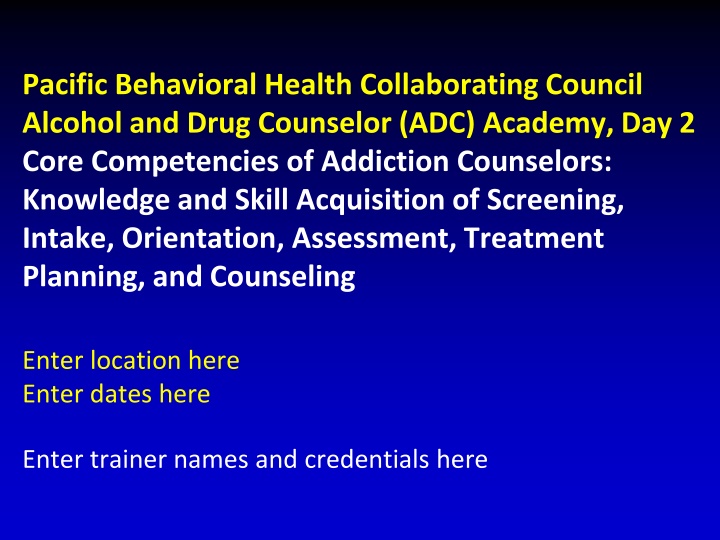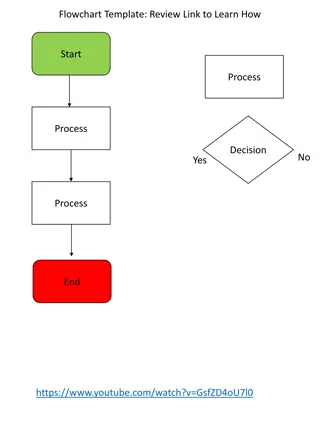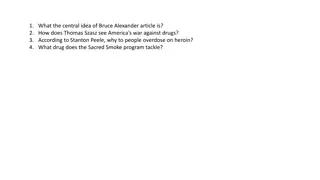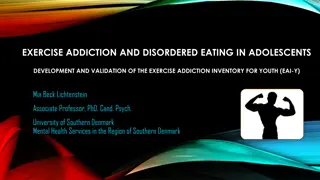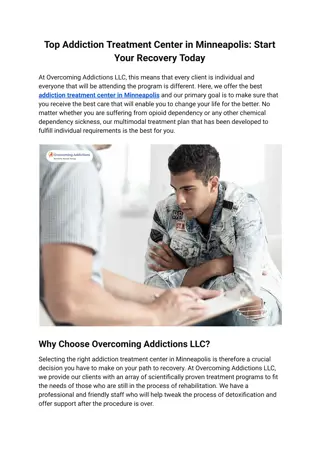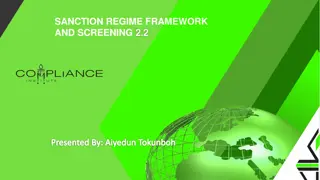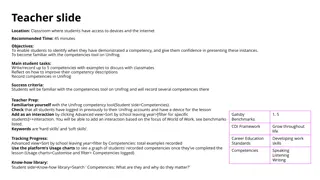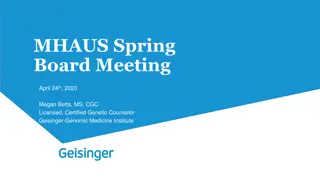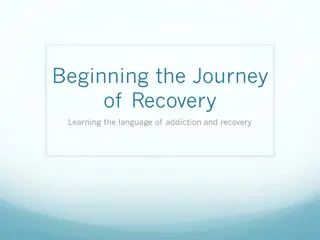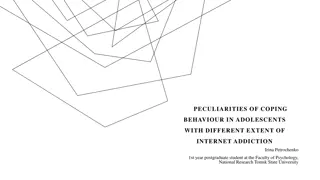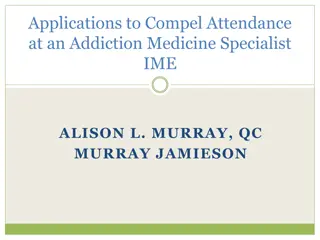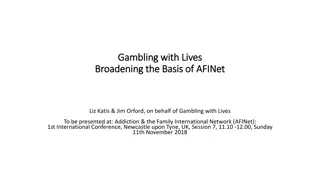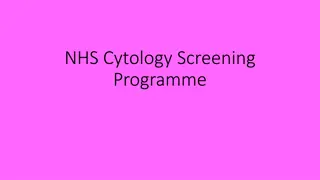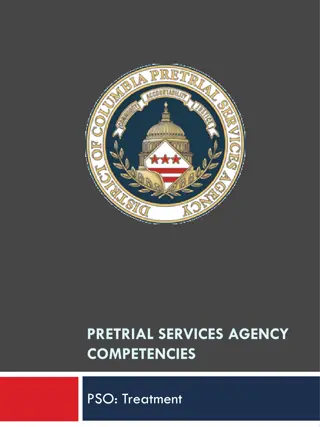Core Competencies of Addiction Counselors: Knowledge Acquisition of Screening, Intake, Assessment
This workshop, part of the Pacific Behavioral Health Collaborating Council Alcohol and Drug Counselor Academy, focuses on the essential skills and knowledge needed for addiction counselors. Topics covered include screening, intake, orientation, assessment, treatment planning, and counseling techniques. Participants will enhance their understanding of these core competencies essential for effective addiction counseling practice.
Download Presentation

Please find below an Image/Link to download the presentation.
The content on the website is provided AS IS for your information and personal use only. It may not be sold, licensed, or shared on other websites without obtaining consent from the author.If you encounter any issues during the download, it is possible that the publisher has removed the file from their server.
You are allowed to download the files provided on this website for personal or commercial use, subject to the condition that they are used lawfully. All files are the property of their respective owners.
The content on the website is provided AS IS for your information and personal use only. It may not be sold, licensed, or shared on other websites without obtaining consent from the author.
E N D
Presentation Transcript
Pacific Behavioral Health Collaborating Council Alcohol and Drug Counselor (ADC) Academy, Day 2 Core Competencies of Addiction Counselors: Knowledge and Skill Acquisition of Screening, Intake, Orientation, Assessment, Treatment Planning, and Counseling Enter location here Enter dates here Enter trainer names and credentials here
Acknowledgements This training was developed by Dr. Thomas E. Freese, PhD (Director of Training of UCLA ISAP and Director of the Pacific Southwest ATTC), Alex R. Ngiraingas, MEd, CSAC II, ICADC, ICPS, and Dr. Christopher C. C. Rocchio, PhD, LCSW, CSAC, ICADC (Clinical Specialist, UCLA) in August of 2018 under contract number 2018-002 by the University of California Los Angeles, Integrated Substance Abuse Programs (UCLA ISAP) and the Pacific Southwest Addiction Technology Center (PSATTC) for the Pacific Behavioral Health Collaborating Council (PBHCC). Additional resource provided by SAMHSA, grant number UR1TI080211. 2
Disclaimer for Training The UCLA, its employees, contractors, and affiliates shall not be liable for any damages, claims, liabilities, costs, or obligations arising from the use or misuse of materials or information contained in this presentation. Any use, copying, or distribution without written permission from the UCLA and the PBHCC is prohibited. 3
Todays Agenda (1) Review and check-in Twelve Core Functions Screening Intake Orientation Assessment Treatment Planning Counseling 4
Agenda for Screening Definition of screening Importance of establishing rapport Importance of using diagnostic criteria DSM-5 Criteria for Substance Use Disorders Context of treatment settings Common screening tasks Global Criteria 5
Definition of Screening Screening is the process by which the counselor, the client, and available significant others review the current situation, symptoms, and other available information to determine the most appropriate initial course of action, given the clients needs and characteristics and the available resources within the community (CSAT, 2006, p.39). The process by which a client is determined to be appropriate and eligible for admission to a particular program (IC&RC) Reference Center for Substance Abuse Treatment. (2006). Addiction counseling competencies: the knowledge, skills, and attitudes of professional practice. Technical Assistance Publication (TAP) Series 21 (HHS Publication No. (SMA) 15-4171). Rockville, MD: Substance Abuse and Mental Health Services Administration. Herdman, J. W. (2018). Global criteria: the 12 core functions of the substance abuse counselor (7th ed.). Lincoln, NE: Parallels: Pathways to Change. 6
Importance of Establishing Rapport Consider the different pathways the client has arrived in your agency. Screening presents hope. Screening provides an opportunity to establish rapport. Screening may influence how the individual engages the SUD system of care. 7
Establishing Rapport (continued) Orient the client to the meeting/screening agenda Listen to understand: use active listening Use open, non-threatening and non-judgmental questions Use simple reflections Use encouraging prompts (e.g., tell me more about that) Use a warm tone of voice Ask clarifying or follow-up questions 8
Importance of Using Diagnostic Criteria All counselors must use objective criteria to determine whether the applicant s alcohol and drug use constitutes a substance use disorder (SUD). All counselors must be familiar with and recognize specific examples of the various psychological, physiological, and social signs and symptoms of SUDs. 9
DSM-5 Criteria and Substance Use Disorders Substance-related disorders Alcohol; Caffeine; Cannabis; Hallucinogens; Inhalants; Opioids; Sedatives, hypnotics, and anxiolytics; Stimulants; Tobacco; Other or Unknown Substance-Related Disorders are divided into 2 groups: Substance Use Disorders Substance-Induced Disorders (intoxication, withdrawal, and other substance/medication- induced mental disorders) Reference American Psychiatric Association. (2013). Diagnostic and statistical manual of mental disorders (5th ed.). Washington, DC: Author. 10
DSM-5 Criteria (continued) Cluster of cognitive, behavioral, and physiological symptoms indicating that the individual continues using the substance despite significant substance-related problems (APA, 2013, p. 483). Eleven (11) criteria organized into four groupings: Impaired control (criteria 1 4), Social impairment (criteria 5 7), Risky use (criteria 8 - 9), and Pharmacological criteria (criteria 10 11) Reference American Psychiatric Association. (2013). Diagnostic and statistical manual of mental disorders (5th ed.). Washington, DC: Author. 11
Impaired Control / Loss of Control Criterion 1: Increased amounts over longer periods of time. The substance is often taken in larger amounts or over a longer period than was intended. Criterion 2: Individual may express desire to cut down or regulate substance use or describe unsuccessful efforts to decrease or quit the substance. Criterion 3: A great deal of time is dedicated to obtaining, using, or recovering from the effects of the substance. Criterion 4: Cravings an intense desire or urge for the substance. Reference American Psychiatric Association. (2013). Diagnostic and statistical manual of mental disorders (5th ed.). Washington, DC: Author. 12
Social Impairment Criterion 5: Recurrent use of the substance may result in a failure to fulfill major obligations at work, school, or home. Criterion 6: Continued use of the substance despite persistent or recurrent social and interpersonal problems cause or exacerbated by the effect of the substance. Criterion 7: Reduction or end to social, recreational, or occupational activities because of substance use. Reference American Psychiatric Association. (2013). Diagnostic and statistical manual of mental disorders (5th ed.). Washington, DC: Author. 13
Risky Use Criterion 8: Recurrent use in situations where it is physically hazardous to use the substance. Criterion 9: Continued use of the substance despite knowledge of having a persistent or recurrent physical or psychological problems likely to have been caused or exacerbated by the substance. Reference American Psychiatric Association. (2013). Diagnostic and statistical manual of mental disorders (5th ed.). Washington, DC: Author. 14
Pharmacological Criteria Criterion 10: Tolerance Increased dose to achieve desired effect. Reduced effect when usual dose is consumed. Tolerance may be difficult to determine by history alone, consider laboratory tests or other methods (e.g., alcohol). Individual variability of the initial sensitivity to the effects of different substances. Reference American Psychiatric Association. (2013). Diagnostic and statistical manual of mental disorders (5th ed.). Washington, DC: Author. 15
Pharmacological Criteria (continued) Criterion 11: Withdrawal Blood or tissue concentrations of a substance decline prolonged heavy use. Use to maintain homeostasis or to relieve symptoms. Variability in symptoms across different classes of substances. Marked and measurable physiological signs common in some substances (e.g., alcohol) whereas none in others (e.g., hallucinogens). Neither tolerance or withdrawal are necessary for a diagnosis of a substance use disorder. Reference American Psychiatric Association. (2013). Diagnostic and statistical manual of mental disorders (5th ed.). Washington, DC: Author. 16
Severity and Specifiers Severity is based on the number of symptom criteria endorsed: Mild: Presence of 2 3 symptoms Moderate: Presence of 4 5 symptoms Severe: Presence of 6 or more symptoms Severity may change over time. Specifiers In early remission (e.g., individual just stopped using) In sustained remission On maintenance therapy (e.g., methadone) In a controlled environment (e.g., hospital or residential treatment center) Reference American Psychiatric Association. (2013). Diagnostic and statistical manual of mental disorders (5th ed.). Washington, DC: Author. 17
Recording Procedures and the DSM-5 Record the name of the specific substance. Substances not categorized into 10 classes should be recorded as other substance use disorder, and specify the specific substance. Identify and record ALL substance use disorders. Reference American Psychiatric Association. (2013). Diagnostic and statistical manual of mental disorders (5th ed.). Washington, DC: Author. 18
Context of Treatment Setting Understanding the context of the treatment setting is critical! What is the treatment modality, environment, and philosophy of the program? What is the level of care? 19
Context (continued) The determination of a potential client s appropriateness for a program requires a great degree of judgment and skill. Important factors include: Physical health condition of the client The psychological functioning of the client Outside supports and resources Previous treatment efforts Motivation for change Reference Herdman, J. W. (2018). Global criteria: the 12 core functions of the substance abuse counselor (7th ed.). Lincoln, NE: Parallels: Pathways to Change. 20
Common Screening Tasks Assemble and complete screening forms. Screening forms generally ask questions regarding the client s demographics (age, sex, residence), presenting problems, previous treatment efforts, level of commitment to change, outside recovery supports, and insurance. Analyze all information to determine client eligibility and appropriateness for program. If client is appropriate, begin arrangements for intake. If client is not appropriate, investigate referral options and discuss options with the client (see Referral). 21
Global Criteria for Screening 1. Evaluate the psychological, social, and physiological signs & symptoms of alcohol and other drug abuse. 2. Determine the client s appropriateness for admission or referral. 3. Determine the client s eligibility for admission or referral. 4. Identify any coexisting conditions (medical, psychiatric, physical, etc.) that indicate the need for additional assessment and/or services. 5. Adhere to applicable laws, regulations, and agency policies governing alcohol and drug abuse services. Reference Herdman, J. W. (2018). Global criteria: the 12 core functions of the substance abuse counselor (7th ed.). Lincoln, NE: Parallels: Pathways to Change. 22
Group Activity for Screening Establish your own outpatient treatment center. What is the name of your outpatient treatment center? Who does your center serve? What screening tools and processes will you use? Be prepared to report out Be prepared to ask questions and offer suggestions to support your colleagues 23
Todays Agenda (2) Review and check-in Twelve Core Functions Screening Intake Orientation Assessment Treatment Planning Counseling 24
Agenda for Intake Definition Common tasks at intake Importance of confidentiality Global Criteria 25
Definition of Intake The IC&RC defines intake as the administrative and initial procedures for admission into a program Reference Herdman, J. W. (2018). Global criteria: the 12 core functions of the substance abuse counselor (7th ed.). Lincoln, NE: Parallels: Pathways to Change. 26
Common Tasks at Intake Complete agency-specific intake forms. Conduct intake interview. Assign primary counselor and other members of the treatment team. Discuss privacy and confidentiality. 27
Importance of Confidentiality and Intake Educate the client to various state and federal rules and regulations protecting their identity. Explain in both oral and written form. Explained in a way that can be easily understood Addressing confidentiality builds trust and rapport. Addressing confidentiality minimizes anxiety. 28
Global Criteria for Intake 6. Complete the required documents for admission. 7. Complete the required documents for program eligibility and appropriateness. 8. Obtain appropriately signed consents when soliciting information from, or providing information to, outside sources to protect client confidentiality and rights. Reference Herdman, J. W. (2018). Global criteria: the 12 core functions of the substance abuse counselor (7th ed.). Lincoln, NE: Parallels: Pathways to Change. 29
Group Activity for Intake What does intake look like in your outpatient center? What specific forms do clients need to complete at intake? What processes will you employ to ensure clients know what they are signing? Be prepared to report out to the larger group. Be prepared to ask questions and offer suggestions to support your colleagues. 30
Todays Agenda (3) Review and check-in Twelve Core Functions Screening Intake Orientation Assessment Treatment Planning Counseling 31
Agenda for Orientation Definition Designing an orientation process Common orientation tasks Global Criteria 32
Definition of Orientation The IC&RC defines orientation as describing to the client the general nature and goals of the program; the rules governing client conduct and infractions that can lead to disciplinary action or discharge from the program; in a non-residential program, the hours during which services are available; the treatment costs that are to be borne by the client, if any; and the client rights Reference Herdman, J. W. (2018). Global criteria: the 12 core functions of the substance abuse counselor (7th ed.). Lincoln, NE: Parallels: Pathways to Change. 33
Designing an Orientation Process Describing essential information about the program to support clients with assimilating into the program so that the client can focus on treatment. Choosing culturally-and linguistically-informed processes for presenting information to diverse client groups. Presenting rules, regulations, and consequences for program infractions that is easily understood by clients. 34
Designing a Process (continued) Aim to create a safe, warm and welcoming space where clients may discuss their fears and misconceptions about treatment. Aim to create a safe and secure space where clients are encouraged to ask questions about rules, regulations, and expectations. Aim to create a process to ensure clients understand their rights and responsibilities. 35
Common Orientation Tasks If applicable, complete an orientation checklist which may include, but not be limited to the following: Overview of program philosophy and treatment modalities used, program expectations and client responsibilities, and program rules and regulations Provide a tour of the facility. If residential or inpatient, assign bed and screen clothing and personal belonging for contraband materials. 36
Common Orientation Tasks (continued) Review and have clients sign an acknowledgement form that they have reviewed, understand, and have received a copy of their rights. Client rights should include, but not be limited to: Assurance of privacy and confidentiality Right to review and participate in treatment planning Impartial access to treatment Recognition of personal property Visits, mail, and telephone calls 37
Global Criteria for Orientation 9. Provide an overview to the client by describing program goals and objectives for client care. 10.Provide an overview to the client by describing program rules and client obligations and rights. 11.Provide an overview of program operations. Reference Herdman, J. W. (2018). Global criteria: the 12 core functions of the substance abuse counselor (7th ed.). Lincoln, NE: Parallels: Pathways to Change. 38
Group Activity for Orientation Who does orientation look like in your outpatient center? Create a checklist. What agenda items would you include would you include in your checklist? Be prepared to report out. Be prepared to ask questions and offer suggestions to support your colleagues. 39
Todays Agenda (4) Review and check-in Twelve Core Functions Screening Intake Orientation Assessment Treatment Planning Counseling 40
Agenda for Assessment Definition Goals of assessment Orienting and preparing clients for assessments Best practices in assessment Common assessment domains American Society of Addiction Medicine (ASAM) Criteria Global criteria 41
Definition of Assessment Assessment is an ongoing process through which the counselor collaborates with the client and others to gather and interpret information necessary for planning treatment and evaluating client progress (CSAT, 2006, p.46). Assessment is defined by the IC&RC as those procedures by which a counselor/program identifies and evaluates an individual s strengths, weaknesses, problems and needs for the development of the treatment plan Reference Center for Substance Abuse Treatment. (2006). Addiction counseling competencies: the knowledge, skills, and attitudes of professional practice. Technical Assistance Publication (TAP) Series 21 (HHS Publication No. (SMA) 15-4171). Rockville, MD: Substance Abuse and Mental Health Services Administration. Herdman, J. W. (2018). Global criteria: the 12 core functions of the substance abuse counselor (7th ed.). Lincoln, NE: Parallels: Pathways to Change. 42
Goals of Assessment Synthesize, integrate, analyze and interpret information necessary for planning treatment and evaluating client progress. First step in shared decision making. Ensure that the client is matched to the right level of care within the SUD treatment continuum. Identify client strengths and resources that may support them in their own recovery. Identify the client s unique needs and preferences. Identify potential and real barriers to treatment. Communicate findings and treatment recommendations to clients, their supporters, and to others involved in their care. Reference Adams, N. & Grieder, D. M. (2014). Treatment planning for person-centered care: shared decision making for whole health (2nd ed.). Waltham, MA: Elsevier Inc. 43
Goals of Assessment (continued) In a recovery-oriented, strengths-based, person- centered, culturally-and linguistically-informed approach to care, the focus is on action rather than on emphasizing and cataloging all deficits and problem areas. Individualized treatment requires comprehensive assessments. Assessment is more than gathering data it is the initiation of building a trusting, helping, healing and therapeutic relationship. Assessments are not static. Reference Adams, N. & Grieder, D. M. (2014). Treatment planning for person-centered care: shared decision making for whole health (2nd ed.). Waltham, MA: Elsevier Inc. 44
Orienting and Preparing the Client for the Assessment Orient the client to the assessment process: How long? What kinds of questions will be asked? What are the limits to confidentiality? Orienting the client to the use of laboratory testing. Reference Morrison, J. (2014). The first interview (4th ed.). New York, NY: Guilford Press 45
Best Practices in Assessment Be present Minimize potential distractions Be accepting and encouraging Be sensitive to culture and gender Ask for clarification Use a combination of open questions and reflections Allow for silence Focus on balancing present behavior with history If permitted and with consent, seek out information from collateral contacts Reference Substance Abuse and Mental Health Services Administration. (2005). Substance abuse treatment for persons with co-occurring disorders. Treatment Improvement Protocol (TIP) Series 42 (HHS Publication No. (SMA) 13-3992). Rockville, MD: Substance Abuse and Mental Health Services Administration. 46
Common Assessment Domains History (comprehensive and longitudinal) and current use of substances SUD treatment history Acute safety risk related to intoxication or withdrawal Sociocultural history Interpersonal and family history, including parenting and caregiver history Reference Center for Substance Abuse Treatment. (2009). Substance abuse treatment: addressing the specific behavioral health needs of women. Treatment Improvement Protocol (TIP) Series 55 (HHS Publication No. (SMA) 09-4426). Rockville, MD: Substance Abuse and Mental Health Services Administration. Substance Abuse and Mental Health Services Administration. (2013). Addressing the specific behavioral health needs of men. Treatment Improvement Protocol (TIP) Series 55 (HHS Publication No. (SMA) 13-4736). Rockville, MD: Substance Abuse and Mental Health Services Administration. Substance Abuse and Mental Health Services Administration. (2005). Substance abuse treatment for persons with co-occurring disorders. Treatment Improvement Protocol (TIP) Series 42 (HHS Publication No. (SMA) 13-3992). Rockville, MD: Substance Abuse and Mental Health Services Administration. 47
Assessment Domains (continued) Educational, vocational, and military history Legal history Housing status Spirituality and religiousness Medical history and physical health Mental health and treatment history Motivation Strengths and coping skills Reference Center for Substance Abuse Treatment. (2009). Substance abuse treatment: addressing the specific behavioral health needs of women. Treatment Improvement Protocol (TIP) Series 55 (HHS Publication No. (SMA) 09-4426). Rockville, MD: Substance Abuse and Mental Health Services Administration. Substance Abuse and Mental Health Services Administration. (2013). Addressing the specific behavioral health needs of men. Treatment Improvement Protocol (TIP) Series 55 (HHS Publication No. (SMA) 13-4736). Rockville, MD: Substance Abuse and Mental Health Services Administration. 48
Assessment and Matching Clients Using ASAM Criteria Dimension I Acute Intoxication and/or Withdrawal Potential (withdrawal management services) Dimension II Bio-Medical Conditions & Complications (physical health services) Dimension III Emotional, Behavioral or Cognitive Conditions & Complications (mental health services) Reference Mee-Lee, David. (Eds.) (2013) The ASAM criteria: treatment for addictive, substance-related, and co-occurring conditions. Chevy Chase, MD: American Society of Addiction Medicine 49
Assessment and Matching Clients (continued) Dimension IV Readiness to Change (motivational services) Dimension V Relapse, Continued Use, Continued Problems Potential (relapse and prevention services) Dimension VI Recovery and Living Environment (recovery support services) Reference Mee-Lee, David. (Eds.) (2013) The ASAM criteria: treatment for addictive, substance-related, and co-occurring conditions. Chevy Chase, MD: American Society of Addiction Medicine 50
